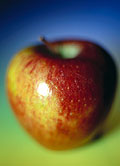- Navigating Your Midlife Crisis: Embracing New Possibilities
- City Raccoons Showing Signs of Domestication
- Mapping the Exposome: Science Broadens Focus to Environmental Disease Triggers
- One Week Less on Social Media Linked to Better Mental Health
- Your Brain Changes in Stages as You Age, Study Finds
- Some Suicide Victims Show No Typical Warning Signs, Study Finds
- ByHeart Formula Faces Lawsuits After Babies Sickened With Botulism
- Switch to Vegan Diet Could Cut Your Greenhouse Gas Emissions in Half
- Regular Bedtime Does Wonders for Blood Pressure
- Dining Alone Could Mean Worse Nutrition for Seniors
Apples Are American Kids’ Favorite Fruit


Apples are the favorite fruit of U.S. kids and young people, accounting for almost 20 percent of all fruit consumed, a new study finds.
This childhood fave takes an even bigger slice of the fruit pie when apple juice is added to the tally, the researchers said.
“Apples and apple juice alone account for 30 percent of total fruit intake,” said study author Kirsten Herrick, a senior service fellow with the U.S. National Center for Health Statistics.
The study doesn’t say whether this is good news or not. “They’re a good fruit option, but there are a rainbow of fruits to consider that offer a variety of different minerals and vitamins,” she said.
Also, “substituting whole fruits for 100-percent fruit juices is always a good choice,” Herrick said.
A diet rich in fruits and vegetables is associated with a healthy weight and decreased risk of diabetes, stroke, cancers and other deadly conditions, the researchers pointed out. But estimates from 2007-2010 showed that only 40 percent of U.S. children met Department of Agriculture recommendations for one to two cups of fruit a day, Herrick said.
“In general, kids are not eating enough fruit,” she said.
Until now, information has been lacking about the specific types of fruit kids eat, she added. That’s where the new study comes in.
The researchers examined the results of 2011-2012 surveys on the food habits of more than 3,100 children and young people aged 2 to 19 years. The investigators found that whole fruits made up 53 percent of fruit consumption overall, and 100-percent fruit juices made up 34 percent. The rest consisted of mixed-fruit products and beverages that aren’t 100-percent fruit.
Apples made up 19 percent of fruit intake, followed by citrus juice (14 percent), apple juice (10 percent) and other fruit juices (9 percent). Next in popularity were bananas and melons, the survey found. Avocados, which are actually berries, weren’t included because a database considered them to be vegetables, Herrick said.
The research didn’t find any differences in fruit consumption between males and females or kids from rich or poor families. Black kids are less likely to eat whole fruit and more likely to drink fruit juice than kids of other races, and those of Asian heritage consume the most whole fruits and the least fruit juice, the findings showed.
“The study can’t speak to why these differences exist,” Herrick said, but other research suggests that ethnic culture and fruit availability are major factors.
Bonnie Braun, a nutrition specialist and professor emerita at the University of Maryland School of Public Health, welcomed the study. The findings are helpful to researchers, policymakers, parents and nutrition educators, she said.
What should parents do? “Scientists and nutritionists seem to have consensus around one key message: Eat a variety of fruits in multiple colors,” she said. “Their second key message is: The more whole fruits, the better.”
Braun said that it’s also wise to adjust portion size by age and size of the child or young adult. Also, she added, parents should watch what they eat themselves since they influence kids, and they should expose children to a variety of fruits and vegetables.
The study was published online Sept. 21 in the journal Pediatrics.
More information
For more about kids and proper diets, see the American Heart Association.
Source: HealthDay
Copyright © 2025 HealthDay. All rights reserved.










